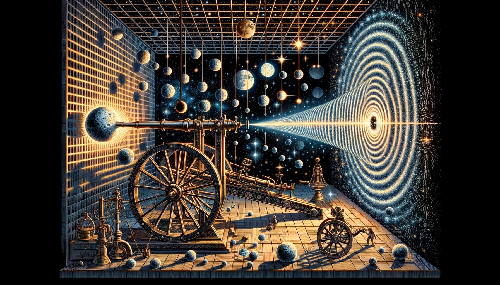The Mind-Bending Mysteries of Quantum Mechanics
Quantum mechanics is one of the most fascinating and perplexing fields in physics. It challenges our fundamental understanding of the universe, revealing a world where particles can exist in multiple states simultaneously, interact instantaneously across vast distances, and behave in ways that defy classical intuition. Here are some of the most mysterious and mind-blowing facts about quantum mechanics that continue to intrigue scientists and enthusiasts alike.
1. Superposition: The Quantum Coin Toss
Imagine flipping a coin. In our everyday experience, the coin lands either heads or tails. But in the quantum realm, particles can exist in a state of superposition, where they can be both heads and tails at the same time. This concept was famously illustrated by the Schrödinger’s cat thought experiment, where a cat in a sealed box is simultaneously alive and dead until observed. Superposition is a cornerstone of quantum mechanics, leading to numerous technological advancements, including quantum computing.
2. Entanglement: Spooky Action at a Distance
Albert Einstein famously described quantum entanglement as “spooky action at a distance.” When particles become entangled, their states become intertwined, such that the state of one particle instantly influences the state of another, regardless of the distance between them. This phenomenon has been experimentally confirmed and is so perplexing because it suggests that information can travel faster than the speed of light, challenging our understanding of space and time.
3. Quantum Tunneling: The Ghostly Passage
Quantum tunneling is the phenomenon where particles pass through energy barriers that, according to classical physics, should be impenetrable. It’s as if a ball could roll through a hill rather than over it. Quantum tunneling is essential for many natural processes, including nuclear fusion in stars and the functioning of semiconductor devices in modern electronics.
4. The Uncertainty Principle: Limits of Precision
Heisenberg’s Uncertainty Principle states that certain pairs of physical properties, like position and momentum, cannot be simultaneously measured with arbitrary precision. The more accurately we know one property, the less accurately we can know the other. This principle fundamentally limits our ability to predict the behavior of quantum systems and underscores the inherent randomness of the quantum world.
5. Wave-Particle Duality: The Dual Nature of Light and Matter
In the quantum realm, particles such as electrons and photons exhibit both wave-like and particle-like properties. This duality is famously demonstrated in the double-slit experiment, where particles passing through two slits create an interference pattern typical of waves. However, when observed, they behave like individual particles, highlighting the strange and context-dependent nature of quantum objects.
6. Quantum Decoherence: The Collapse of Superposition
Quantum decoherence explains how quantum systems lose their quantum behavior and transition to classical states due to interactions with their environment. This process is crucial for understanding why we don’t observe superposition and entanglement in our macroscopic world. Decoherence remains a hot topic in the quest to build stable and scalable quantum computers.
7. The Quantum Zeno Effect: Freezing the Quantum State
Named after the ancient Greek philosopher Zeno, the Quantum Zeno Effect occurs when frequent measurements of a quantum system prevent it from evolving. In essence, constantly observing a particle can “freeze” it in its current state, akin to watching a pot that never boils. This effect has practical implications in quantum control and information processing.
8. Virtual Particles: The Quantum Vacuum
In quantum field theory, the vacuum is not empty but teeming with virtual particles that pop in and out of existence. These ephemeral particles contribute to various quantum effects, such as the Casimir effect, where two uncharged, parallel plates experience an attractive force due to vacuum fluctuations. Virtual particles also play a role in the force of gravity and the stability of the vacuum itself.
Conclusion
Quantum mechanics continually reshapes our understanding of reality, challenging our classical intuitions and opening up new realms of possibility. As we delve deeper into the quantum world, we uncover more mysteries and opportunities, from advanced technologies like quantum computing and cryptography to profound questions about the nature of the universe. The journey into the quantum realm is far from over, promising even more astonishing discoveries in the future.





